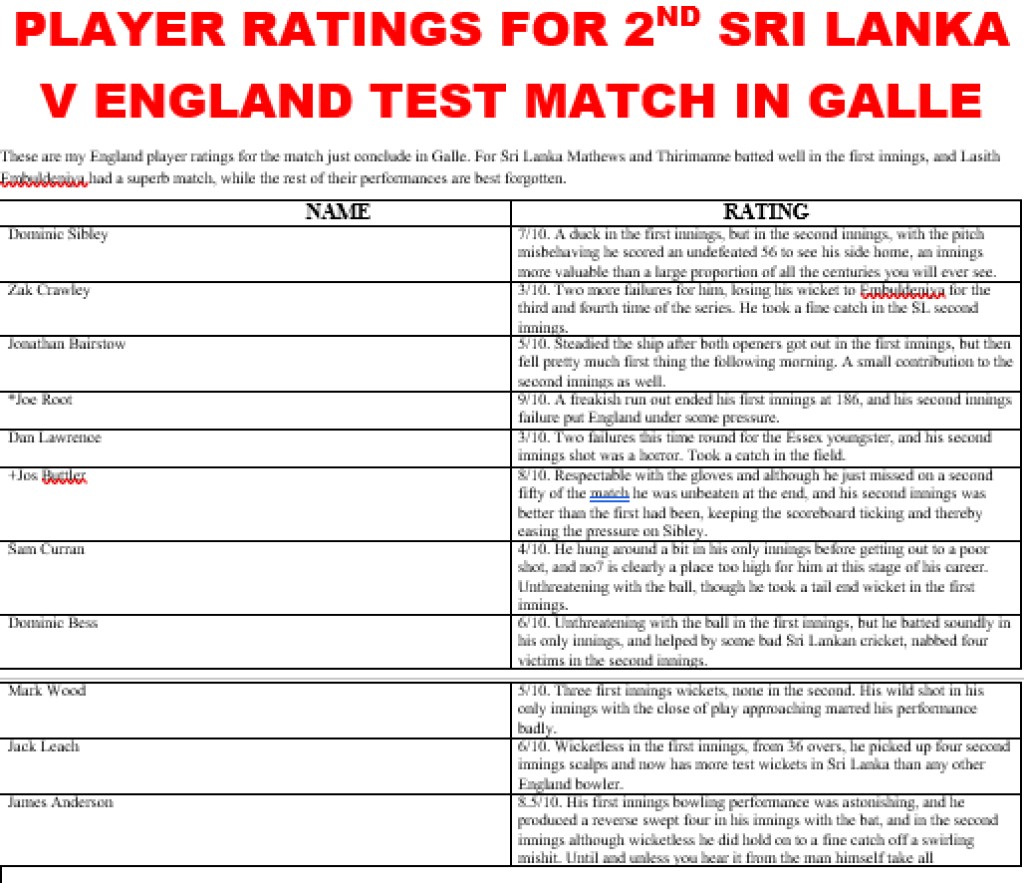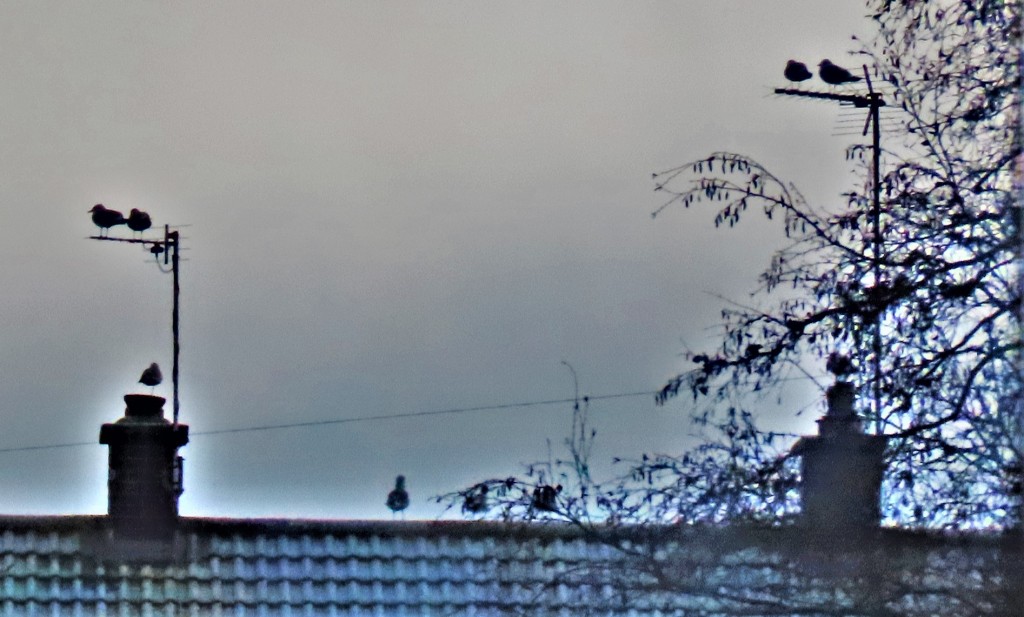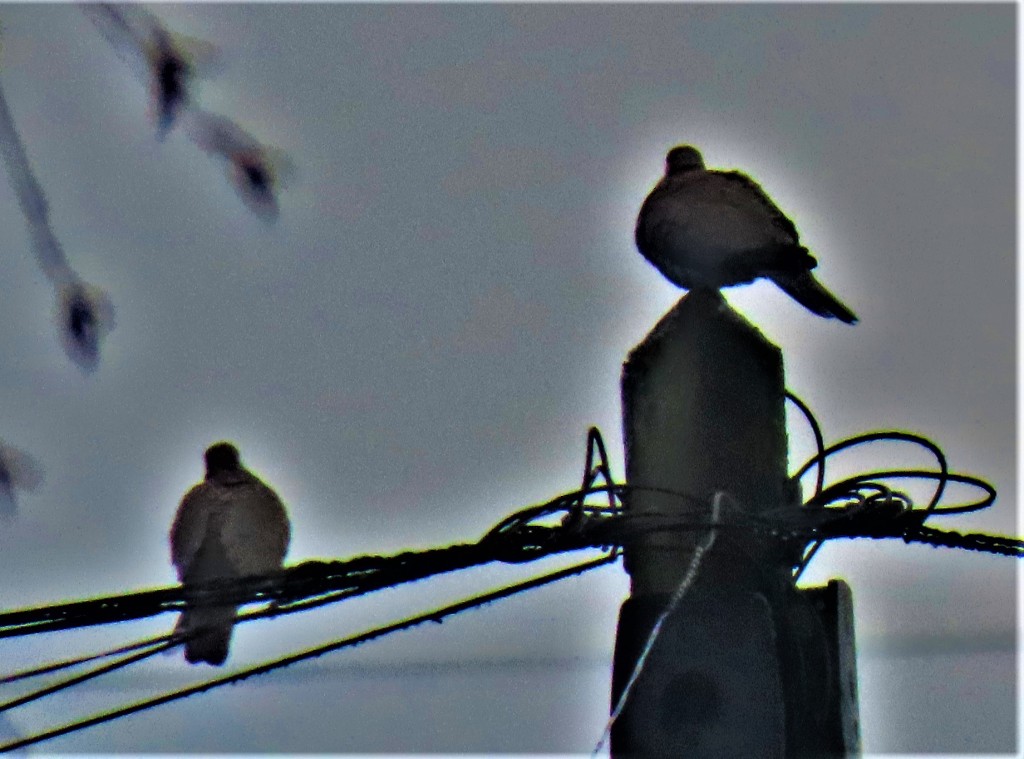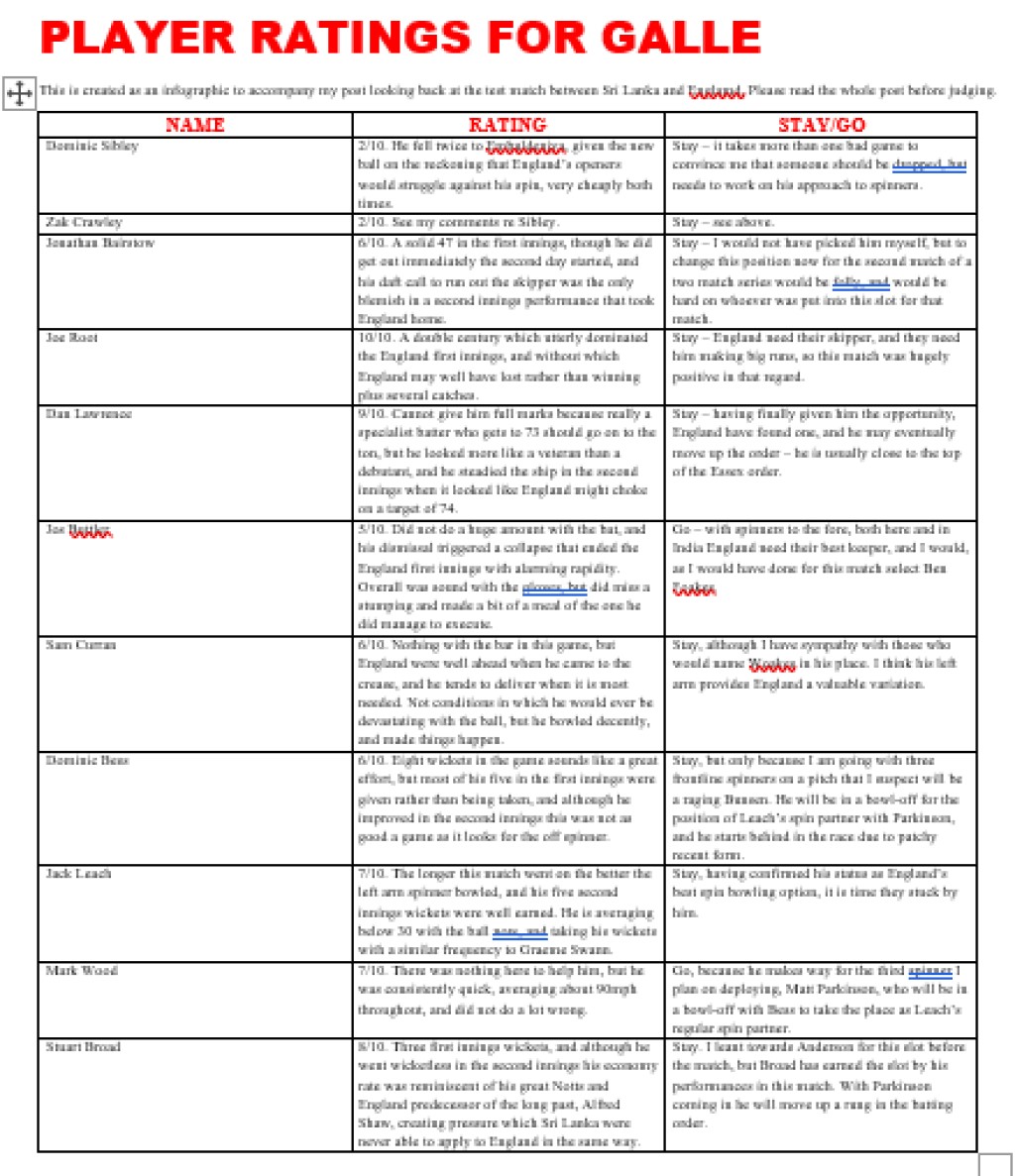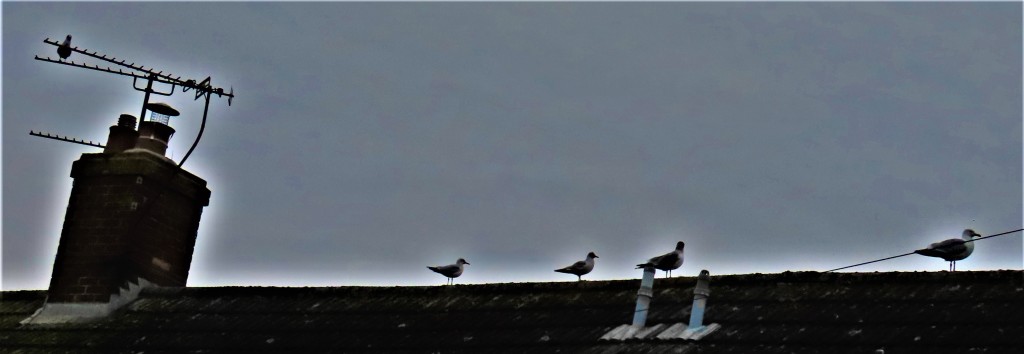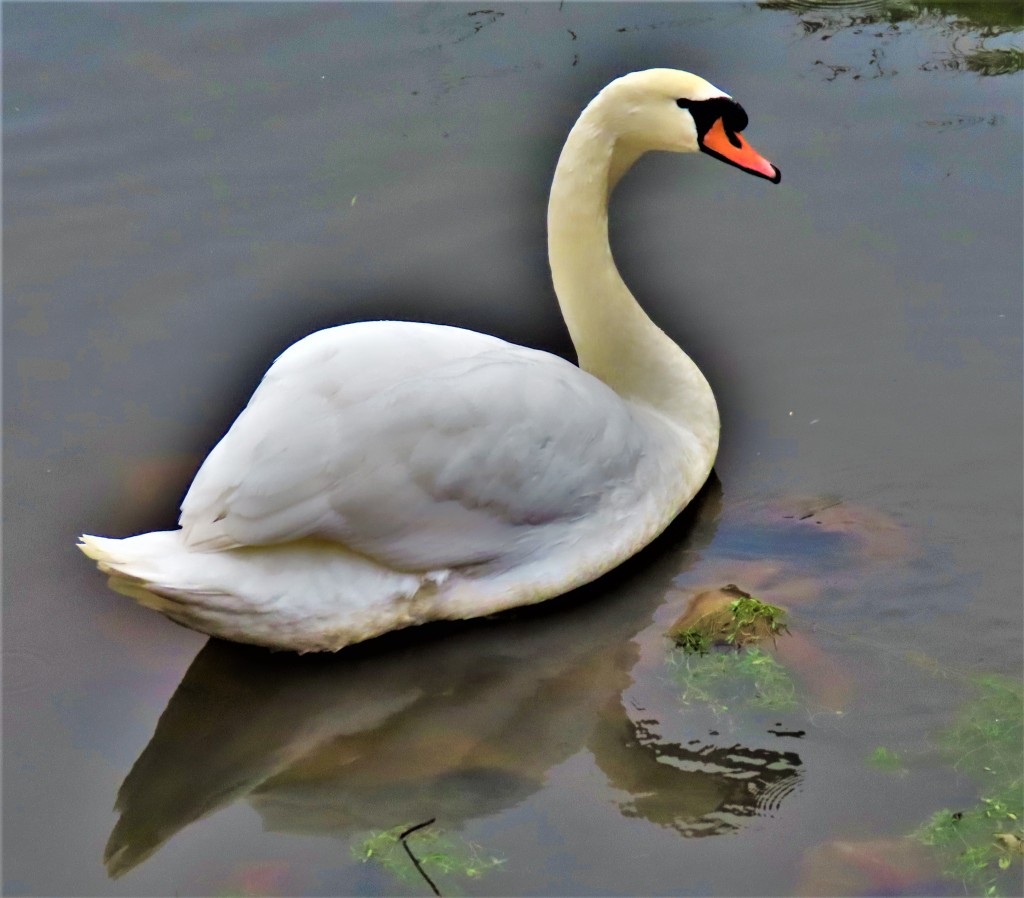This post deals with the events that unfolded in Galle today, which started with England very much second favourites.
ENGLAND FIRST INNINGS
England resumed 42 runs adrift with one wicket left in their first innings. Five runs were accumulated, four of them by way of a reverse sweep from James Anderson before the end came. Embuldeniya did not add to his seven wickets, but his day was far from done…
SRI LANKA SECOND INNINGS
Sri Lanka started their second innings with an advantage of 37, and plenty of time to build a daunting lead. Unfortunately they lost their heads rather dramatically. Jack Leach and Dominic Bess, bowling much better than they had in the first innings and assisted by some kamikaze batting from the Sri Lankans picked up wickets quickly. By lunch Sri Lanka were six down, and two more wickets fell soon after. There were two splendid catches, Crawley doing well to hang on to one that was hit out of the middle of the bat but straight at him, and Anderson getting underneath a swirling mishit. Embuldeniya, barely rested from his bowling stint, proceeded to play an innings that shamed most of his supposed betters with the bat, producing a first class career best 40 chock full of common sense. He succeeded in having Bess removed from the attack, but then he and no11 Asitha Fernando fell to successive Joe Root deliveries, leaving Sri Lanka all out for 126, and England facing a target of 164 to win.
ENGLAND 2ND INNINGS
Crawley did reach double figures for the first time in the series, but then honoured protocol by falling to Embuldeniya for the fourth successive time. Bairstow made a small contribution, Root failed, and Lawrence played a poor shot before he had given himself time to get a proper sight of the ball. At that point the score was 89-4, and England were by no means safe. Embuldeniya had three of the wickets, giving him ten for the match. Sibley was grinding away at one end, and was now joined by Buttler. Buttler batted sensibly, keeping the scoreboard ticking, although Sri Lanka were not doing nearly enough to make things difficult – singles were regularly there for the taking. As England closed in, Sibley completed a 50 which was worth more than a century on a flat track would have been. He had his good fortune, with a couple of close LBW appeals being turned down and being labelled “umpire’s call” by the DRS. However, the second of the two had hit him above the knee roll, and he is quite tall, so one can understand why it was considered too high by the umpire. Also, all fortune, good or ill, to one side, he showed an immense amount of character after a very poor series up to that point. Buttler just missed out on what would have been his second fifty of the match, but he was there at the end as England won by six wickets, to take the series 2-0.
THE PLAYER OF THE MATCH AWARD AND EMBULDENIYA
England’s win by six wickets effectively ensured that Joe Root, who had a second successive great game, would be player of the match. Had Sri Lanka bowled England out a second time and emerged victorious Embuldeniya would have been a deserving recipient, and even had the margin been three wickets rather than six he would have merited consideration. As it was a margin as comfortable as six wickets really did mean that someone from the winning team had to be chosen, and with all respect to Anderson and to Sibley for his gritty second innings effort Root was the only serious candidate. Root was also the Player of the Series, which was an absolute shoo-in. Embuldeniya’s combination of 40 and a 10 wicket haul got some of us thinking about other notable combinations of runs with big wicket hauls, and here are six of the best from test history:
- Melbourne 1883 – Billy Bates took seven wickets in each innings, including England’s first ever test hat trick, and scored 55 in England’s only innings
- The Oval 1902 – Hugh Trumble scored 64 not out and 7 not out and took eight first innings and four second innings wickets, but as with Embuldeniya could not win it for his side, England sneaking home by one wicket. Trumble had the best match aggregate for Australia with 71 runs, and bowled unchanged through both England innings for his 12 wicket haul.
- Alan Davidson 1960 – He took 5-135 in the West Indies first innings of 453, 6-87 in their second innings 284 and contributed 44 to Australia’s first innings 505 and 80 to their second innings 232, having to settle for a place in history as part of test cricket’s first ever tie, rather than a win.
- Ian Botham, Bombay 1980 (it was not called Mumbai in those days) – 6-58, 114 not out when no one else even topped 50, 7-48 in an innings victory.
- Imran Khan, Faisalabad 1982 – 6-98, 117, 5-82 in an innings win over India
- Richard Hadlee, Brisbane 1985 – 9-52 in the first innings, an all time test record for an out and out fast bowler, a blistering 54 (four of each kind of boundary) which enabled skipper Coney to declare with two full days in hand for Australia to be dismissed a second time, and six more wickets to finish the job.
ENGLAND PLAYER RATINGS
Dominic Sibley – 7/10. His gritty second innings saved a dire series for him, and spared England some potentially major blushes, sending him and them on to India in good heart.
Zak Crawley – 3/10. Two horrific failures with the bat, but he did hold one fine catch during the Sri Lankan second innings.
Jonathan Bairstow – 5/10. stabilised the ship in the England first innings after both openers had gone cheaply, but did then get out first thing on the following morning. A modest contribution to the second innings. Although he batted well at times he never did so for long enough in this series, as evidenced by a highest score of 47.
Joe Root – 9/10. 186 in the first innings, a couple of wickets to end the Sri Lankan second innings, but a failure at a crucial moment in the England second innings blotted his otherwise stellar copybook, costing him one mark.
Dan Lawrence – 3/10. A double failure with the bat this time, and his second innings shot was quite awful. He did take a catch in the field along the way.
Jos Buttler – 7/10. A fifty in the first innings, just missed out on that mark in the second, but played a crucial role in seeing England home. A competent effort with the gloves.
Sam Curran – 4/10. Largely unthreatening with the ball, though he did bag a wicket in the first innings, he hung around briefly with the bat, but did nothing to alter the impression that no7 is a place too high for him in a test batting order.
Dominic Bess – 7-10. His first innings bowling was largely unthreatening, he played a fine support knock in England’s first innings, and bagged four wickets in the second innings.
Mark Wood – 5/10. Three first innings wickets, none in the second. His shot near the end of day three was a poor one, and an absolute shocker in the circumstances.
Jack Leach – 7/10. Toiled through 36 overs in the first innings, getting no wickets. Bowled well in the second and was rewarded with four wickets. He now has more wickets in Sri Lanka than any other England bowler.
James Anderson – 8.5/10. Without his bowling in the first innings England would have been buried – SL would have had over 500 on the board. In the second innings he did not get among the wickets but did take a fine catch, doing well to get under a swirling mishit.
This is England’s fifth successive away test victory, their best run on foreign soil since they followed victories in the last four matches of the 1911-2 Ashes with another three to start the 1913-4 tour of South Africa. The bowling spearhead then was another right arm fast medium with Lancashire connections, albeit more to league cricket than to the county, Sydney Francis Barnes, and he was just a shade older than Anderson is now, being past 40 by the end of the South African series. India will be a much tougher tour – this Sri Lankan team are not used to winning, and that manifests itself in an obvious lack of killer instinct at key moments, whereas India surmounted huge difficulties to best the Aussies in their own backyard.
PHOTOGRAPHS
I end as usual with some photographs…

